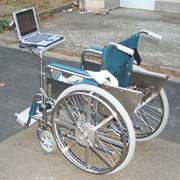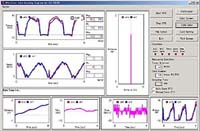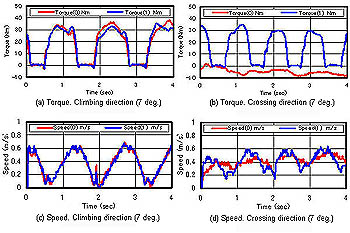Development of an Experimental Wheelchair
January, 2001 by Koichi Hirata

We have developed an experimental wheelchair to use various experiments like the situation on a waving ship. The wheelchair has a low production cost, because it has simple measuring equipments. It also is developed in thinking of easy handling for the experiments. In this site, we show the measuring equipments and a measuring program for the wheelchair.
 Equipments of the Wheelchair Equipments of the Wheelchair
 The drive torque of the experimental wheelchair is measured with general-purpose foil strain gages. The revolving angle of each wheel is measured with a rotary encoder, which has 2000 pulses per one revolution. The whole measuring equipments use a dry battery or a storage battery as sources of electricity. Thus, the wheelchair can be experimented with easy handling, because it does not need any external electric wire for the sources of electricity.
The drive torque of the experimental wheelchair is measured with general-purpose foil strain gages. The revolving angle of each wheel is measured with a rotary encoder, which has 2000 pulses per one revolution. The whole measuring equipments use a dry battery or a storage battery as sources of electricity. Thus, the wheelchair can be experimented with easy handling, because it does not need any external electric wire for the sources of electricity.
 Introduction of the Hardware Introduction of the Hardware
 Calibration of the Strain gages Calibration of the Strain gages
 Program of a Microcomputer Program of a Microcomputer
 Download of CAD Data Download of CAD Data
 Link to Related Sites Link to Related Sites
 Measuring Program Measuring Program
 The experimental wheelchair carries a portable type personal computer. The measuring program on the computer calculates a speed, a locus, a power and other technical results from the torque and the revolving angle in which taken by an analog/digital (A/D) converter board and a digital input and output (DIO) board. The program can also read and indicate the saved data. We develop the program to get the easy handling for the experiments.
The experimental wheelchair carries a portable type personal computer. The measuring program on the computer calculates a speed, a locus, a power and other technical results from the torque and the revolving angle in which taken by an analog/digital (A/D) converter board and a digital input and output (DIO) board. The program can also read and indicate the saved data. We develop the program to get the easy handling for the experiments.
 An Explanatory Note of the Software An Explanatory Note of the Software
 Detailed Information of the Program Detailed Information of the Program
 An Example of Experimental Results An Example of Experimental Results
 As a trial run, the wheelchair was experimented on an experimental slope with 7 deg of inclination. It ran climbing direction and crossing direction as the experimental condition. The figure at the right shows experimeted results of the relationships between the operating time, the torque (Nm) and the speed (m/s). In the figure, red lines represent that of the left wheel, and blue lines represent that of the right wheel. From the figure, we can look the characteristics of the drive torque and speed of each wheel. It was also confirmed that the difference of the characteristics of the climbing and crossing directions.
As a trial run, the wheelchair was experimented on an experimental slope with 7 deg of inclination. It ran climbing direction and crossing direction as the experimental condition. The figure at the right shows experimeted results of the relationships between the operating time, the torque (Nm) and the speed (m/s). In the figure, red lines represent that of the left wheel, and blue lines represent that of the right wheel. From the figure, we can look the characteristics of the drive torque and speed of each wheel. It was also confirmed that the difference of the characteristics of the climbing and crossing directions.
|

 Equipments of the Wheelchair
Equipments of the Wheelchair The drive torque of the experimental wheelchair is measured with general-purpose foil strain gages. The revolving angle of each wheel is measured with a rotary encoder, which has 2000 pulses per one revolution. The whole measuring equipments use a dry battery or a storage battery as sources of electricity. Thus, the wheelchair can be experimented with easy handling, because it does not need any external electric wire for the sources of electricity.
The drive torque of the experimental wheelchair is measured with general-purpose foil strain gages. The revolving angle of each wheel is measured with a rotary encoder, which has 2000 pulses per one revolution. The whole measuring equipments use a dry battery or a storage battery as sources of electricity. Thus, the wheelchair can be experimented with easy handling, because it does not need any external electric wire for the sources of electricity. Introduction of the Hardware
Introduction of the Hardware
